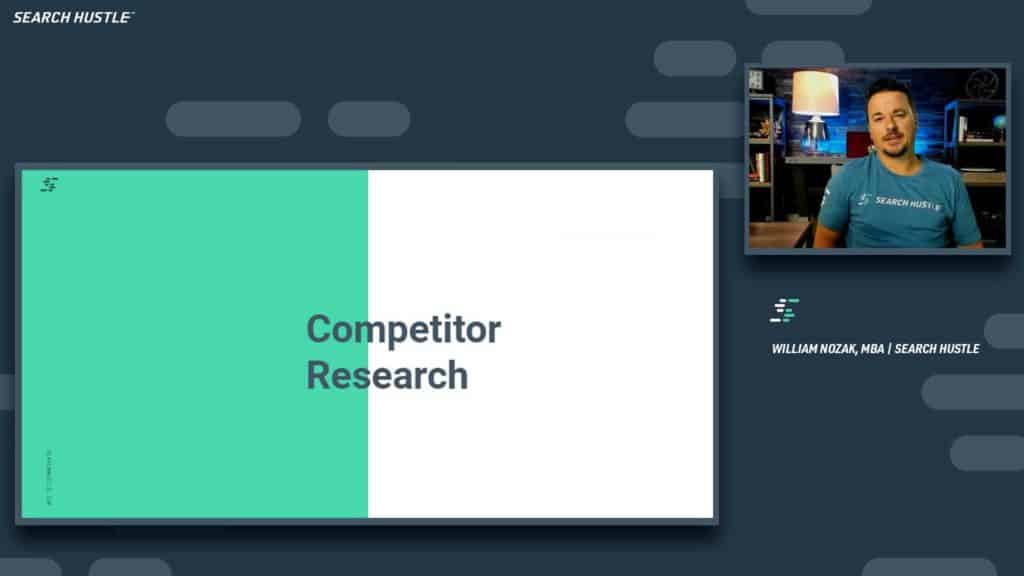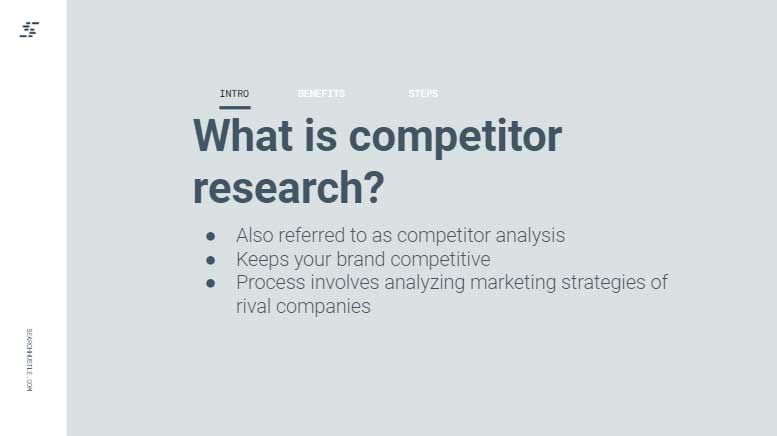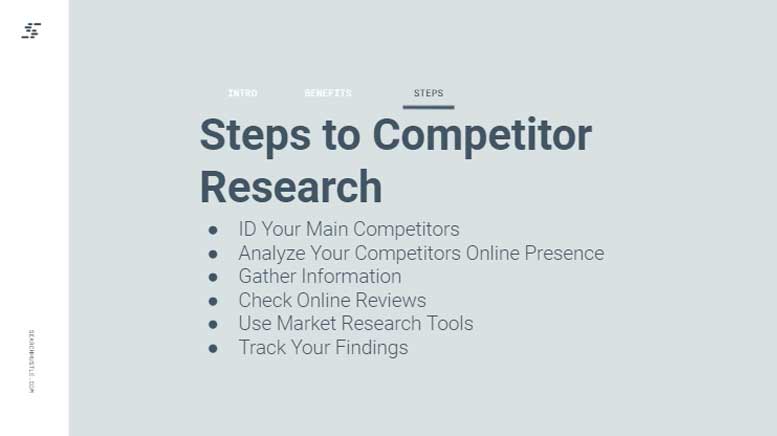Competitor Research
Assess how the business can improve by using competitor research to uncover the strengths and weaknesses of businesses in the same market as you.

Often referred to as competitor analysis, we call it “Competitive Intelligence” and present these findings to clients in what we term a CI report. This type of research does require a significant time commitment, but it is a tactic that keeps the brand highly competitive.
Competitor research facilitates a better understanding of businesses that compete for customers. This form of research is more than simply taking a peek at a rival company’s latest social media posts. We’re talking about true war room tactics: Google reviews (volume, frequency, good, bad, and responses), website access, LinkedIn posts/profiles, site auditing (speed checks, content checks, gap checks, authority checks, etc.), keyword research, link research, ads research, to name a few.
It is impossible to build a solid marketing campaign without real qualitative and quantitative data. Guessing and hypothesizing can lead the business down the wrong roads, as we find that business owners and marketers aren’t always downstream from the business offerings.
Instead, successful competitor research is a plan with goals and benchmarks that work together to benefit and advance the success of a business.

What is Competitor Research?
In its most simplistic form, competitor research is the process of analyzing the marketing strategies of a rival. Through this research, you should be able to assess their strengths, weaknesses, opportunities, and threats and discover gaps the business can capitalize on.
The competitive research results should be compiled into a document where all relevant team members can access the data. If the information is utilized correctly, the business should be able to innovate new ways to develop and grow within its industry.
New insights can be gained with things like what drives traffic to the competitor’s web pages, what they’re doing to gain new leads, how they retain current customers, how many steps are in their funnels, what their value proposition is, and much more.
Through competitor research, the business will be able to:
Understand The Market
Market research and how competitors operate can make your services and products stand out through marketing. Researching competitors and having a firm grasp on current trends within the market can keep product/service prices competitive and allow you to exert initiative in marketing campaigns.
Identify Gaps In the Market
Once the competitor research is complete, it’s all about how to implement it. Ideally, gaps will be found in the market that can be exploited.
These gaps can cover a wide range of information.
- Maybe a competitor struggles with employee retention (Glassdoor or Indeed)
- Has no social media presence (Facebook, Twitter, Instagram)
- Uses YouTube or LinkedIn with great success
- Doesn’t run ads on Google or Facebook
- Untapped referral opportunities driving volumes of traffic to rival sites
- Produced a specific asset that performs well
- Using a unique set of keywords or content to drive traffic
Plan for the Future
Changing markets can cause the business to be left behind, surpassed by the competition that better understands the internet, industry trends, current and future users, and future-use cases. Competitor research can allow the business to learn from the past mistakes of other companies within the same market, as well as see how they handled certain shifts in the industry. In turn, this data can help exploit successful strategies for future scenarios that might occur.

Steps to Competitor Research
Almost every action a competitor makes in digital marketing can be tracked and analyzed. The different steps of research will help to construct comprehensive marketing objectives to keep the business growing and successful.
ID The Main Competitors
First, decide which competitors should be researched. The analysis should include both the direct and indirect competitors and look at local and regional (national, international, online, etc.).
A business that provides a similar product or service, or operates in the same geographic area, is a direct competitor. An indirect competitor is a business that offers different products or services but still fulfills a similar need or solves a similar problem for a customer.
Second, use the research to compare brands, form goals, and develop marketing strategies focusing on direct competitors.
Analyze The Competitors Digital Footprint
If the competitor’s website is outranking the business website in organic search, there has to be a reason. If they have a higher rank in the SERPs, then it’s likely the competitor is also generating more impressions, clicks, leads, and revenue.
Uncovering details about their SEO/SEM practices can help you develop an effective strategy.
Aside from tracking the organic performance of a competitor in the SERPs, keep an eye on their PPC efforts. While researching this, pay close attention to the search volume and CPC of the keywords used in PPC ads.
Finally, be sure to research the social media strategy of competitors. Platforms like Instagram, YouTube, Twitter, LinkedIn, and Facebook all allow companies to run ads. When clicking these ads, users can be directed to a custom landing page. So make sure you review their landing pages as well.
An example of a few footprint components that should be analyzed include:
- The competitor’s most successful keywords and organic rankings.
- What pages have the highest hits due to organic search?
What socials and other directories do they utilize, and how often. - How they utilize CTAs.
- The keyword volume and difficulty score of keywords used by competitors.
- Loading speeds.
- Who links back to their website.
- The overarching theme at the page level.
- The overarching theme at the website level.
- Performance of the mobile version of the site and how user-friendly it is.
- Their value proposition.
- Their robots.txt.
- Their previous positions in the Wayback Machine.
It is crucial to learn what type of message, value proposition, presence, or brand the competitors are trying to portray on these platforms. This research informs the types of visuals, offers, and messaging to be used on the platform.
Gather Information
There is a vast quantity of other collectible data from competitors to supplement the research and strengthen marketing objectives.
To maintain a competitive edge on pricing, you should always know the competitor’s pricing, discounts, and deals.
Read all Google reviews and understand what people say they do and don’t do well. Seek to exploit this information in any ad copy.
Another vital factor is whether the competitors offer online shopping and what their shipping costs look like. Lately, consumers prefer the convenience that online shopping offers. In 2020, around 88% of the adult population in the U.S. made an online purchase, and that figure is expected to climb.
For example, if the biggest competitors offer free shipping, then offer the same cost-cutting feature. Support options are another notable “feature” you want to check out.
- Webinars
- Whitepapers
- Podcasting
- Infographics
- Press Releases
- FAQs Section
- Content, content, content
Always pay close attention to the content strategy of the competitors. If a rival has a blog, find out the following:
- What topics do they cover?
- How long are their posts?
- What formats (HTML, audio, video, images) are they using?
- How often do they post?
These details will give you the benchmarks for your own content strategy.
Check Online Reviews
Online reviews can show what customers really think about a competitor. If you discover multiple negative reviews making similar complaints, there’s a window of opportunity. What about positive reviews? These are helpful, too, as you should look at them as a client’s wants and, in other regards, a competitor’s strengths. Let’s use an example. Say you find negative reviews that complain about products breaking soon after being used and customer support being unresponsive. You can take this insight and have your marketing campaign tout these factors as your product’s strengths.
Use Market-Research Tools
With digital marketing, there are several market research tools at your disposal. Many of these tools will require a paid subscription, while a few are either free or allow a free trial for several days.
Google Alerts: You can monitor the web for specific phrases. This tool can track your brand name along with competitor names. Also, set alerts for unique industry phrases that might be relevant.
Backlink/Content Checkers and Tools: This type of tool can view a competitor’s backlink profile, domain strength, successful content, and content gaps. This gives actionable insights into a competitor’s strategies and strengths and even helps you uncover potential traffic sources.
Quora: Often overlooked, Quora is a free forum-style site that offers valuable insight into what customers think. By checking Quora, a lot can be learned about what customers are saying about the competition.
This is just a very small sampling of the many market/competitor research tools (SEMRush, Google AdWords, Google Trends, AHREFS, Screaming Frog, competitor websites, Siteliner, and any keyword density tools). Whichever tools are chosen, they should paint a picture of the competitors’ digital SWOT and strategies that you would otherwise be unable to uncover at first glance.
Track The Findings
All the findings should be compiled into a single document. You can then organize the data to visualize better what has been learned. Try to record the same data points for each competitor you analyze.
Before comparisons are drawn, be sure to have a baseline established for your own business. Be sure to record all relevant information into the spreadsheet as you would for the competitor.
Why Ongoing Competitor Research is Key
Keep in mind that markets always change. If you’re not keeping constant tabs on it, you risk being unaware of a major shift until it’s too late. That’s why maintaining ongoing competitor analysis is key to success.
In the end, competitor research should give you a competitive edge by learning from and adopting a rival’s successful marketing strategies while maintaining your own.
Market Research is a vital component of any effective strategy in the modern marketplace. The reason for this is that you have to continually learn about who your audience is, along with the audience of your competitors. Analytics and research tools that provide this information can be a powerful edge against the competition.
The more you can adapt to the needs and wants of your audience, the more you can draw away customers from the competition.

Ready to Take Your Search Hustle Further?



